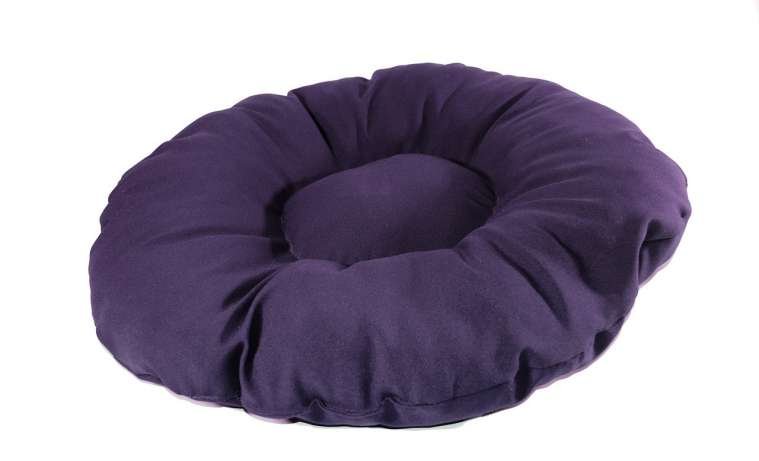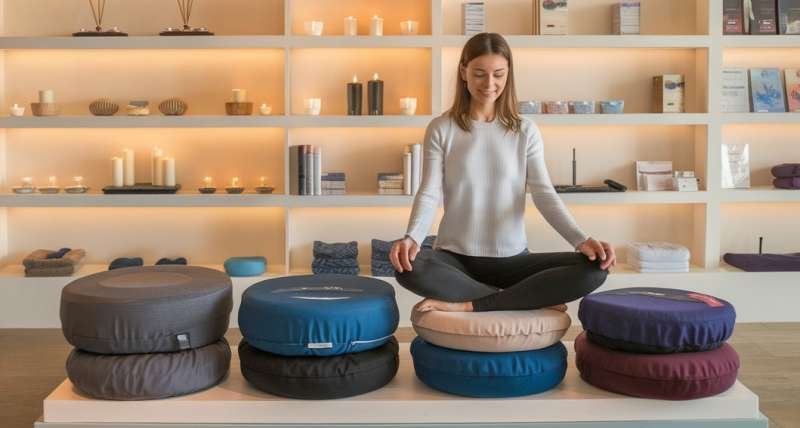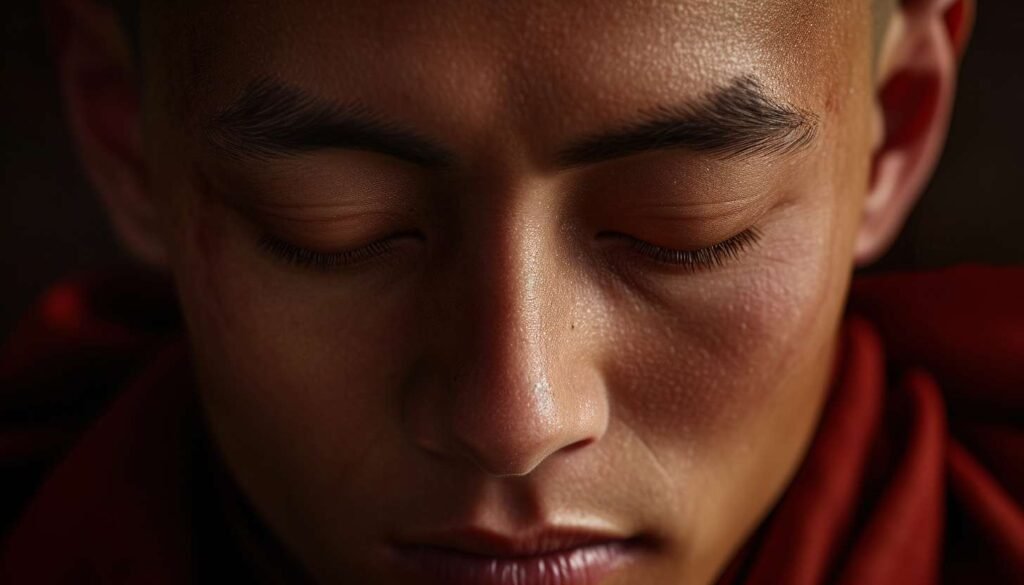In this article
- Introduction
- What is a Meditation Cushion?
- Are Cushions Necessary for Practice?
- Understanding Meditation Cushion Types
- Factors to Consider When Choosing
- Material Matters
- Finding the Right Height and Support
- Comfort and Aesthetics
- Budget-Friendly Options
- Testing and Trying Before Buying
- How to Clean and Maintain Meditation Cushion?
- Conclusion
🧘♀️ Are you tired of aching knees and an uncomfortable back during meditation? Your quest for inner peace shouldn’t be marred by physical discomfort. The right meditation cushion can be a game-changer, transforming your practice from a struggle to a serene experience.
But with so many options out there, how do you choose the perfect meditation cushion for you? It’s not just about picking the prettiest or the priciest one. The ideal cushion should align with your body, support your posture, and enhance your meditation journey. From understanding different types to considering factors like height, material, and budget, there’s a lot to unpack.
In this guide, we’ll walk you through everything you need to know about selecting the right meditation cushion. You’ll learn what makes a great cushion, why it matters for your practice, and how to find one that fits you like a glove. So, let’s dive in and discover how a simple cushion can elevate your meditation experience to new heights of comfort and tranquility.
What is a Meditation Cushion?
A meditation cushion, also known as a meditation pillow or zafu, is a specially designed support used to enhance your meditation practice. This essential tool helps you maintain proper posture and comfort during extended periods of seated meditation. Unlike ordinary pillows, meditation cushions are crafted to elevate your hips, allowing for better spine alignment and reducing strain on your lower back and legs.
These cushions come in various shapes and sizes, with the most common being round or crescent-shaped. They are typically filled with materials like buckwheat hulls, kapok, or foam, which provide both support and adaptability to your body’s contours. The primary purpose of a meditation cushion is to create a stable foundation for your practice, enabling you to focus on your meditation without physical discomfort distracting you.
By using a meditation cushion, you can achieve a more comfortable and sustainable sitting position, which is crucial for developing a consistent meditation routine. Whether you’re a beginner or an experienced practitioner, incorporating a meditation cushion into your practice can significantly improve your overall meditation experience and help you cultivate mindfulness more effectively.

Are Cushions Necessary for Practice?
While meditation can be practiced without a cushion, using one can significantly enhance your experience. You might wonder if investing in a meditation cushion is worth it, especially if you’re new to the practice. The truth is, a cushion can make a world of difference in your comfort and posture during meditation sessions.
When you sit on the floor for extended periods, you may experience discomfort or even pain in your back, hips, or knees. A meditation cushion provides the necessary support to help you maintain proper alignment and reduce strain on your body. This allows you to focus more on your practice and less on physical distractions.
Moreover, a cushion can help you achieve the ideal meditation posture more easily. By elevating your hips slightly, it encourages a natural curvature in your spine, promoting better breathing and circulation. This improved posture can lead to longer, more comfortable meditation sessions, ultimately deepening your practice.
While cushions aren’t strictly necessary, they can be invaluable tools for both beginners and experienced practitioners alike. If you find yourself struggling with discomfort or distraction during meditation, a cushion might be just what you need to take your practice to the next level.
Understanding Meditation Cushion Types
Now that we’ve covered the basics, let’s explore the various types of meditation cushions available to support your practice. Each type offers unique benefits to suit different preferences and needs.
A. Zafu: Traditional round cushions
Zafus are classic, round meditation cushions that elevate your hips and tilt your pelvis forward. This position helps maintain proper spine alignment and reduces leg strain during extended sitting periods.
B. Zabuton: Flat rectangular mats
Zabutons are flat, rectangular mats often used in conjunction with zafus. They provide extra cushioning for your ankles and knees, offering added comfort during longer meditation sessions.
C. Crescent-shaped cushions
Crescent-shaped cushions offer a modern twist on traditional designs. Their unique shape provides excellent thigh support and helps maintain proper posture, making them ideal for those with hip or lower back issues.
D. Bench-style meditation seats
Meditation benches are an alternative to cushions, offering a kneeling position that reduces pressure on the legs and lower back. They’re particularly beneficial for practitioners with knee or ankle concerns.
| Cushion Type | Best For | Key Benefits |
|---|---|---|
| Zafu | Traditional sitting | Hip elevation, spine alignment |
| Zabuton | Additional comfort | Ankle and knee cushioning |
| Crescent | Hip/back support | Thigh support, posture maintenance |
| Bench | Knee/ankle concerns | Reduced leg pressure, kneeling position |
Next, we’ll delve into the crucial factors to consider when selecting the perfect meditation cushion for your practice.
Factors to Consider When Choosing
When selecting the right meditation cushion for you, several key factors come into play. Let’s explore these considerations to help you make an informed decision.
A. Sitting position preferences
Your preferred meditation posture greatly influences the type of cushion you need. Here’s a quick guide:
| Sitting Position | Recommended Cushion |
|---|---|
| Cross-legged | Zafu or crescent |
| Kneeling | Zabuton or bench |
| Lotus | Thin cushion or mat |
B. Body type and flexibility
Your body’s unique characteristics play a crucial role in cushion selection. If you’re less flexible, opt for a higher cushion to ease hip and knee strain. Taller individuals might need extra height, while those with a larger frame may benefit from wider, firmer cushions.
C. Meditation duration
For longer sessions, prioritize comfort and support. Consider:
- Thicker cushions for extended sitting
- Cushions with removable layers for adjustability
- Combining a zafu with a zabuton for added comfort
D. Portability needs
If you meditate in various locations, portability becomes essential. Look for:
- Lightweight materials
- Foldable or inflatable options
- Cushions with carrying handles or bags
E. Indoor vs. outdoor use
Your meditation environment affects cushion choice. For outdoor use, consider:
- Water-resistant or quick-drying fabrics
- Darker colors to hide dirt
- Durable materials that withstand various surfaces
Now that you’re aware of these crucial factors, you’re better equipped to find a cushion that suits your unique needs. Next, we’ll delve into the importance of cushion materials and how they can impact your meditation experience.

Material Matters
When choosing a meditation cushion, the materials used play a crucial role in your comfort and overall experience. You’ll want to consider both the filling and the outer fabric to ensure you’re getting the best support for your practice.
Natural vs. Synthetic Fillings
Natural fillings like buckwheat hulls offer excellent support and conform to your body shape. You’ll find they provide a stable base while allowing subtle movements. On the other hand, synthetic fillings like foam can be more durable and maintain their shape over time. Here’s a comparison:
| Filling Type | Pros | Cons |
|---|---|---|
| Buckwheat | Moldable, breathable | Can be noisy, heavier |
| Kapok | Light, eco-friendly | Less firm, compresses over time |
| Foam | Consistent support, lightweight | Less breathable, less eco-friendly |
Outer Fabric Options
The outer fabric of your meditation cushion affects both comfort and durability. Cotton is breathable and soft, while synthetic materials like polyester can be more resistant to stains and wear. Consider your climate and personal preferences when choosing.
Durability and Maintenance
You’ll want a cushion that can withstand regular use. Look for reinforced seams and high-quality zippers. Some materials are easier to clean than others, so consider how much maintenance you’re willing to do.
Eco-Friendly Considerations
If sustainability is important to you, opt for cushions made with organic materials and natural dyes. Some manufacturers offer cushions with removable covers, allowing you to replace just the cover rather than the entire cushion, reducing waste.
Now that you understand the importance of materials, let’s explore how to find the right height and support for your meditation practice.
Finding the Right Height and Support
When choosing a meditation cushion, finding the right height and support is crucial for maintaining comfort and proper posture during your practice. You’ll want to consider your body’s unique needs and flexibility to ensure a cushion that supports your meditation journey.
Assessing Your Hip Flexibility
Your hip flexibility plays a significant role in determining the ideal cushion height. If you have tight hips, you’ll likely need a higher cushion to maintain comfort and proper alignment. Conversely, if you’re more flexible, a lower cushion might suit you better. Experiment with different heights to find what works best for your body.
Proper Spine Alignment
The right cushion height helps maintain proper spine alignment, which is essential for comfortable and effective meditation. Your cushion should allow you to sit with your hips slightly higher than your knees, creating a gentle downward slope. This position helps keep your spine naturally aligned and reduces strain on your lower back.
Preventing Leg Numbness
Choosing the right cushion can help prevent leg numbness during longer meditation sessions. A cushion that’s too low may cause compression on your legs, leading to discomfort and numbness. Look for a cushion that allows your legs to rest comfortably without excessive pressure.
Adjustable vs. Fixed Height Options
| Feature | Adjustable Height | Fixed Height |
|---|---|---|
| Versatility | Adapts to different needs | Consistent support |
| Customization | Can be modified as needed | One-size-fits-all |
| Longevity | Accommodates changing flexibility | May need replacement as needs change |
Adjustable height cushions offer flexibility, allowing you to modify the support as your practice evolves. Fixed height options provide consistent support but may require replacement as your needs change. Consider your long-term meditation goals when deciding between these options.

Comfort and Aesthetics
When choosing a meditation cushion, comfort and aesthetics play a crucial role in enhancing your practice. You’ll want to find a balance between physical ease and mindful awareness.
Balancing comfort with mindfulness
You should seek a cushion that supports your posture without lulling you into sleepiness. A comfortable cushion helps you maintain focus, but it shouldn’t be so cozy that you lose awareness of your body.
Color and design choices
The visual appeal of your meditation cushion can significantly impact your practice:
- Calming colors: Blues, greens, and neutral tones
- Energizing hues: Warm reds, oranges, and yellows
- Patterns: Simple designs for focus, intricate patterns for inspiration
Matching your meditation space
Consider your meditation environment when selecting a cushion. You’ll want to choose a style that complements your space:
- Minimalist rooms: Opt for solid colors or subtle patterns
- Bohemian spaces: Explore vibrant designs and textures
- Nature-inspired areas: Look for earthy tones and organic materials
Personalizing your cushion
Make your meditation cushion uniquely yours:
- Add meaningful embroidery
- Attach inspiring quotes or affirmations
- Use removable covers for easy washing and style changes
Remember, your meditation cushion is a personal tool for your practice. By choosing one that resonates with you aesthetically and provides comfort, you’ll create a more inviting and effective meditation experience.
Budget-Friendly Options
When it comes to meditation cushions, you don’t have to break the bank to find a comfortable seating solution. Let’s explore some cost-effective options that can enhance your practice without emptying your wallet.
DIY Meditation Cushions
You can create your own meditation cushion with materials you might already have at home. Here’s a simple DIY guide:
- Find a sturdy fabric (like canvas or denim)
- Cut two circular pieces for the top and bottom
- Cut a long strip for the sides
- Sew the pieces together, leaving a small opening
- Fill with buckwheat hulls, rice, or old clothes
- Sew the opening shut
Multi-purpose Cushions
Investing in a versatile cushion can save you money and space. Consider these options:
| Cushion Type | Meditation Use | Alternative Use |
|---|---|---|
| Throw Pillow | Zafu-style seat | Couch decoration |
| Yoga Bolster | Back support | Yoga prop |
| Floor Pouf | Zabuton-style mat | Extra seating |
Affordable Alternatives to Specialized Cushions
You don’t always need a dedicated meditation cushion. Here are some budget-friendly alternatives:
- Folded blankets or towels
- Firm couch cushions
- Outdoor stadium seats
- Rolled-up yoga mat
Remember, comfort is key in meditation. These budget-friendly options can provide the support you need without the hefty price tag of specialized cushions. As you explore these alternatives, keep in mind that the most important factor is finding a position that allows you to sit comfortably for extended periods. Now that you’ve learned about affordable options, let’s discuss how to test and try cushions before making a final decision.
Testing and Trying Before Buying
Before committing to a meditation cushion, it’s crucial to ensure it’s the right fit for you. You have several options to test and try cushions before making a purchase.
In-store trials
When you visit a local yoga or meditation supply store, you’ll often have the opportunity to try out different cushions. Take advantage of this by sitting on various options for a few minutes each. Pay attention to how your body feels and whether the cushion provides adequate support for your posture.
Borrowing from meditation centers
Many meditation centers and studios have cushions available for use during classes. This gives you a chance to experience different types of cushions over longer periods. You might even ask if they’d let you borrow a cushion for a short time to try at home.
Money-back guarantees and return policies
When shopping online, look for retailers offering money-back guarantees or generous return policies. This allows you to test a cushion in your own space and return it if it doesn’t meet your needs. Always read the fine print to understand the terms and conditions of these policies.
Remember, finding the right meditation cushion is a personal journey. What works for others may not work for you, so take the time to explore your options. By testing and trying before buying, you’ll be more likely to find a cushion that enhances your meditation practice and supports your long-term comfort and well-being.
Check out our YouTube channel for more motivational mindfulness videos!
How to Clean and Maintain Meditation Cushion?
Your meditation cushion is an essential companion on your mindfulness journey. To ensure it continues to serve you well, proper care and maintenance are crucial. You’ll want to keep your cushion clean and in good condition to support your practice for years to come.
Regular cleaning is key to maintaining your meditation cushion. You can start by gently vacuuming the surface to remove dust and loose debris. For deeper cleaning, check the care label for specific instructions. Many cushions have removable covers that can be machine-washed on a gentle cycle with mild detergent. However, if your cushion doesn’t have a removable cover, spot cleaning with a damp cloth and mild soap is your best option.
To maintain the shape and support of your cushion, fluff it regularly and rotate it occasionally to ensure even wear. When not in use, store your cushion in a cool, dry place away from direct sunlight to prevent fading and deterioration of the fabric.
Remember, a well-maintained meditation cushion not only lasts longer but also provides a more hygienic and comfortable surface for your practice. By taking care of your cushion, you’re also taking care of your meditation experience.
Conclusion
Choosing the right meditation cushion is a crucial step in creating a comfortable and supportive practice environment. By considering factors such as cushion type, material, height, and support, you can find the perfect cushion that meets your unique needs. Remember to prioritize comfort and proper alignment to enhance your meditation experience and prevent discomfort or strain during longer sessions.
Ultimately, the best meditation cushion is the one that allows you to focus on your practice without distraction. Whether you opt for a traditional zafu, a versatile meditation pillow, or a budget-friendly option, take the time to test different cushions and find the one that feels right for you. With the right cushion supporting your practice, you’ll be well-equipped to deepen your meditation journey and reap the many benefits of this ancient practice.


